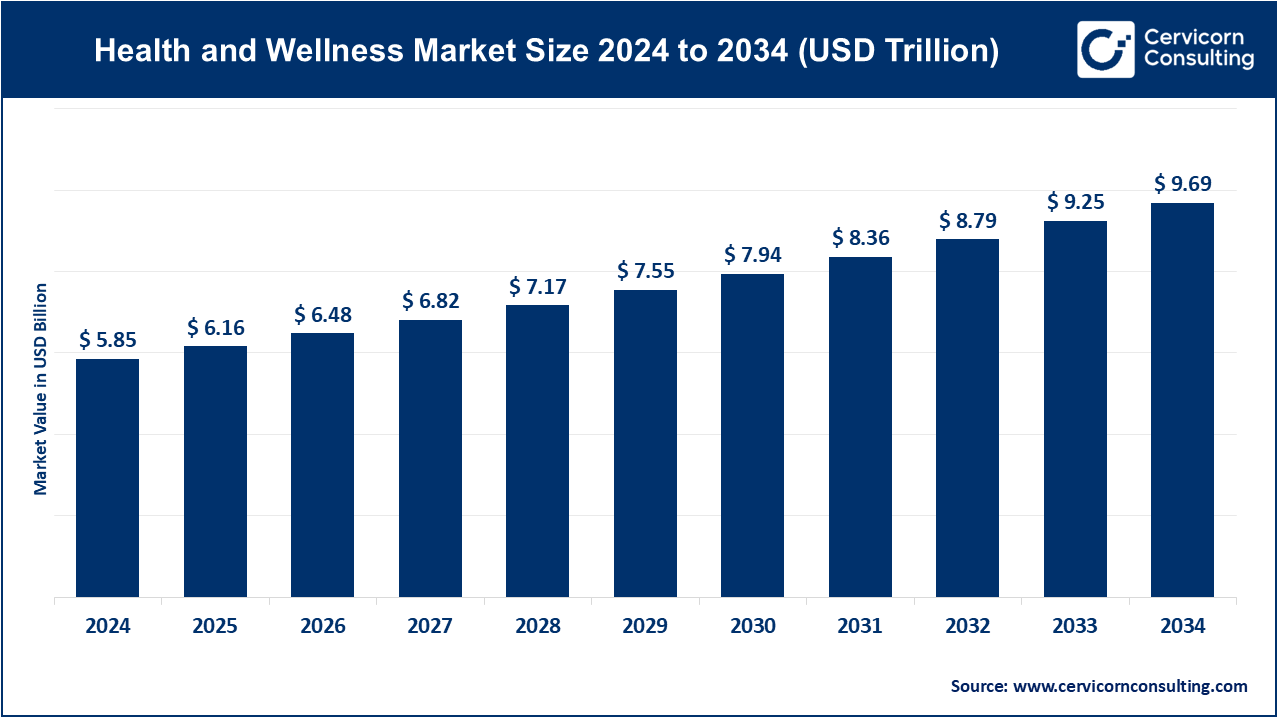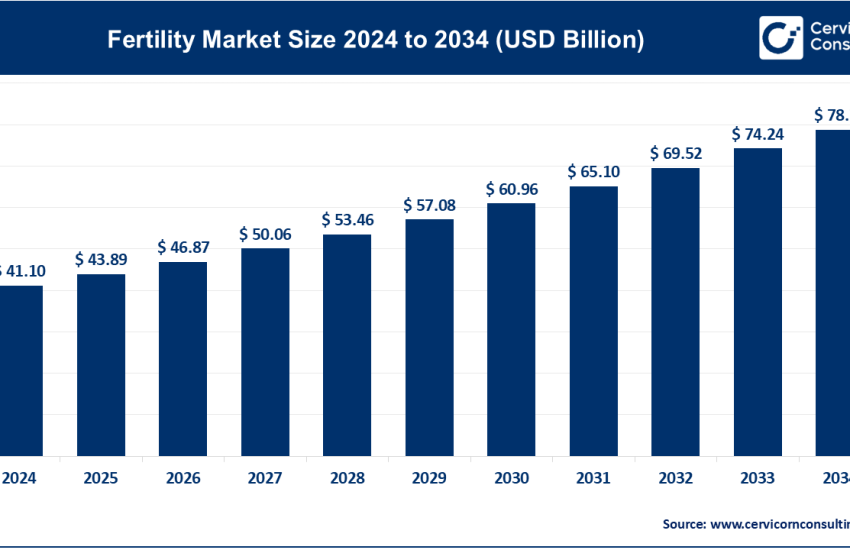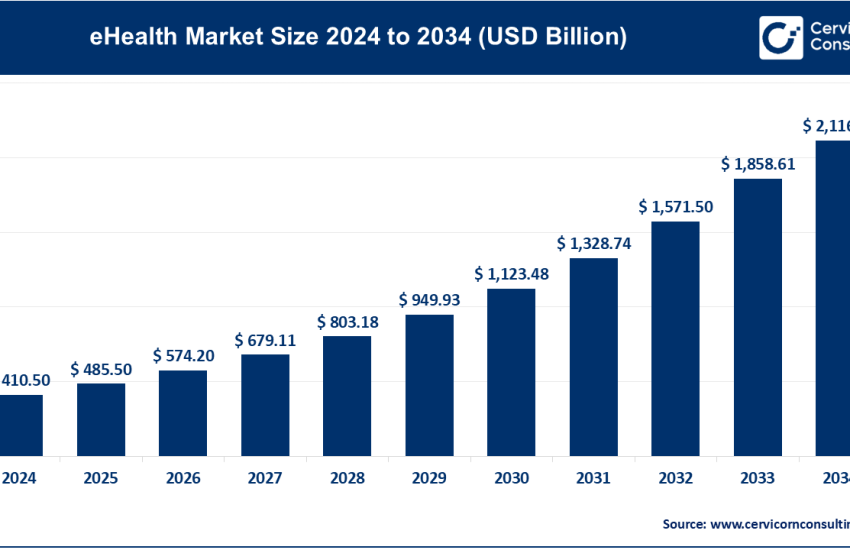Health and Wellness Market Growth Factors, Key Players, Trends, and Regional Insights by 2034
Table of Contents
ToggleHealth and Wellness Market Overview
The global health and wellness market was valued at USD 5.85 trillion in 2024 and is projected to grow to approximately USD 9.69 trillion by 2034, with a compound annual growth rate (CAGR) of 5.17% from 2025 to 2034.
The global health and wellness market has seen remarkable growth in recent years, driven by a combination of shifting consumer preferences, technological advancements, and the increasing emphasis on preventive healthcare. Key factors contributing to this growth include the rise of chronic diseases, increased health awareness, technological innovations in health monitoring, and the growing desire for healthier lifestyles. As consumers become more conscious of their well-being, demand for organic, natural products, fitness-related services, and personalized health solutions has surged.
Moreover, the COVID-19 pandemic accelerated interest in immunity-boosting products and mental wellness, further expanding the market. Governments and private entities have been quick to invest in health innovation, biotechnology, and wellness infrastructure, ensuring that the sector continues to thrive. This momentum is expected to persist, as global markets remain increasingly health-conscious, with a growing desire for holistic solutions to enhance both physical and mental well-being.
What is the Health and Wellness Market?
The health and wellness market encompasses a wide range of products, services, and initiatives that aim to improve the well-being of individuals. It includes sectors such as nutrition, fitness, mental health, personal care, and preventive healthcare. The market is diverse, offering everything from dietary supplements, organic food, and weight management solutions, to fitness equipment, spas, and mindfulness services.
This market is distinct in that it focuses not only on the treatment of illnesses but also on the promotion of overall well-being. It spans across various industries such as pharmaceuticals, food and beverage, personal care, fitness, and healthcare technology. As consumers become more proactive about their health, the health and wellness market has transformed into a multibillion-dollar industry, with products and services designed to support people’s physical, emotional, and social well-being.
Why is the Health and Wellness Market Important?
The importance of the health and wellness market is rooted in its potential to significantly improve the quality of life for individuals around the globe. As the prevalence of chronic conditions like diabetes, hypertension, and heart disease rises, the need for preventive care and healthier living becomes increasingly critical.
The market encourages individuals to adopt healthier habits and lifestyles, ultimately reducing the burden on healthcare systems and enhancing productivity. Mental health, which has long been under-emphasized, has gained prominence in recent years, highlighting the crucial role of wellness products and services in addressing issues such as stress, anxiety, and depression. The convergence of physical and mental wellness is a hallmark of the current landscape, ensuring that holistic approaches to health remain central. Moreover, as more people prioritize wellness, it drives innovation in various sectors, creating new opportunities for businesses and improving global health outcomes.
Get a Free Sample: https://www.cervicornconsulting.com/sample/2351
Leading Companies in the Health and Wellness Market
Several key players dominate the global health and wellness market, offering a wide array of products and services that cater to the needs of health-conscious consumers. Some of the top companies in this sector include:
- Johnson & Johnson
- Specialization: Health and wellness, medical devices, pharmaceuticals, consumer health products
- Key Focus Areas: Personal care, health technology, baby care, skincare, wound care, and over-the-counter medications
- Notable Features: Known for its strong consumer health product portfolio and leadership in medical devices and pharmaceuticals.
- 2024 Revenue (approx.): $94.9 billion
- Market Share: Significant presence in healthcare and wellness across various segments
- Global Presence: Over 60 countries, with a strong footprint in North America, Europe, and Asia
- Nestlé Health Science
- Specialization: Nutritional solutions, medical nutrition, consumer health
- Key Focus Areas: Nutritional supplements, weight management, digestive health, and clinical nutrition
- Notable Features: Focus on science-driven, evidence-based nutrition for health improvement.
- 2024 Revenue (approx.): $16.2 billion
- Market Share: One of the largest players in the nutrition and wellness space
- Global Presence: Operates in over 100 countries, with a strong market presence in Europe and North America
- Procter & Gamble (P&G)
- Specialization: Consumer health, hygiene products, personal care
- Key Focus Areas: Skin and hair care, oral health, wellness products
- Notable Features: A household name in health and wellness products with an emphasis on consumer trust and product effectiveness.
- 2024 Revenue (approx.): $80 billion
- Market Share: Leading position in personal health and wellness products globally
- Global Presence: Operates in nearly every country worldwide
- GSK (GlaxoSmithKline)
- Specialization: Pharmaceuticals, vaccines, consumer healthcare
- Key Focus Areas: Immunology, respiratory health, oral health, pain relief
- Notable Features: A major player in both over-the-counter and prescription health products, including wellness and health-related drugs.
- 2024 Revenue (approx.): $46.3 billion
- Market Share: One of the largest pharmaceutical companies in the world with a focus on both medicinal and wellness products
- Global Presence: Extensive presence, particularly in Europe, the Americas, and Asia
- Pfizer Inc.
- Specialization: Pharmaceuticals, vaccines, wellness products
- Key Focus Areas: Immunization, wellness supplements, cardiovascular health, and preventive care
- Notable Features: Known for developing innovative health solutions, especially during the COVID-19 pandemic.
- 2024 Revenue (approx.): $100 billion
- Market Share: Leading player in the global pharmaceutical and wellness sector
- Global Presence: Operates in over 175 countries
Leading Trends and Their Impact on the Health and Wellness Market
Several key trends have emerged in the health and wellness market, shaping its direction and expanding its influence across various sectors:
- Personalization: As consumers seek more tailored health solutions, there is a growing demand for personalized wellness products, such as personalized supplements, skincare routines, and fitness plans. Advances in technology and data analytics have made it possible for companies to offer customized wellness options, contributing to the market’s growth.
- Technological Advancements: Wearables, health tracking devices, and health-related mobile apps have revolutionized personal healthcare management. Fitness trackers, smartwatches, and telemedicine platforms are now widely used to monitor health metrics and provide real-time health data.
- Mental Health Focus: Mental wellness is becoming increasingly important, with consumers seeking products and services that promote emotional well-being, stress relief, and cognitive health. Meditation apps, yoga, mindfulness training, and therapy services have become essential components of the wellness industry.
- Sustainability: Consumers are becoming more conscious of the environmental impact of the products they use. As a result, the demand for eco-friendly, organic, and sustainable wellness products has skyrocketed. Brands are focusing on reducing their environmental footprint, whether through packaging, ingredient sourcing, or production practices.
- Holistic Health: The integration of physical, mental, and social well-being is a growing trend in the market. Consumers are increasingly looking for solutions that offer a well-rounded approach to health, rather than focusing on individual aspects like fitness or nutrition alone.
Successful Examples of Health and Wellness Initiatives Around the World
Several successful examples demonstrate the growing importance of the health and wellness market:
- WW International (formerly Weight Watchers): WW has successfully integrated digital technology into its weight management programs, offering personalized dieting solutions through a combination of coaching, meal plans, and fitness tracking.
- Peloton: A leading example of the integration of fitness and technology, Peloton offers an at-home workout platform that connects users with live and on-demand fitness classes. The company has revolutionized the fitness industry by combining high-quality workout equipment with interactive fitness experiences.
- Meditation Apps (Calm and Headspace): These apps have tapped into the growing mental wellness trend, offering users tools for managing stress, anxiety, and improving sleep through guided meditation and mindfulness practices.
- Herbalife: Herbalife has built a global brand based on nutrition, wellness, and weight management products. Their use of personalized nutrition, along with a direct selling model, has allowed them to maintain a strong presence in the health and wellness space.
Regional Analysis and Government Initiatives Shaping the Market
The health and wellness market is shaped by regional dynamics, with different regions facing unique challenges and opportunities.
North America: The North American market is one of the largest, driven by a growing focus on chronic disease management, fitness, and mental health. Governments in the region have initiated various public health programs and campaigns aimed at reducing the burden of preventable diseases. In the U.S., the Affordable Care Act and various wellness initiatives have contributed to the rise of preventive healthcare services.
Europe: European markets have seen a rise in the demand for natural and organic health products. The European Union’s regulatory frameworks for health and wellness products have shaped the development of safe and effective consumer health solutions. Policies promoting sustainability and eco-friendly wellness products are also gaining traction.
Asia-Pacific: The Asia-Pacific region is experiencing rapid growth in the health and wellness sector, driven by rising disposable incomes, urbanization, and increased health awareness. Governments in countries like China and India have focused on improving healthcare infrastructure and promoting preventive care. The region is also home to a growing appetite for traditional wellness practices, such as yoga and acupuncture.
Latin America: In Latin America, the health and wellness market is expanding as a result of increased awareness of lifestyle diseases and an emerging middle class. Countries like Brazil and Mexico are seeing a shift toward healthier eating habits, fitness trends, and wellness tourism. Government initiatives aimed at improving public health and reducing obesity rates have been key drivers of this growth.
Middle East and Africa: The Middle East and Africa are witnessing a transformation in health and wellness due to increasing healthcare investments, rising health-consciousness, and growing awareness of fitness. Governments in the region are focusing on building better healthcare infrastructure and promoting healthier living through public health campaigns.
To Get Detailed Overview, Contact Us: https://www.cervicornconsulting.com/contact-us
Read Report: U.S. Behavioral Health Market Trends, Insights, and Leading Companies (2024-2033)



